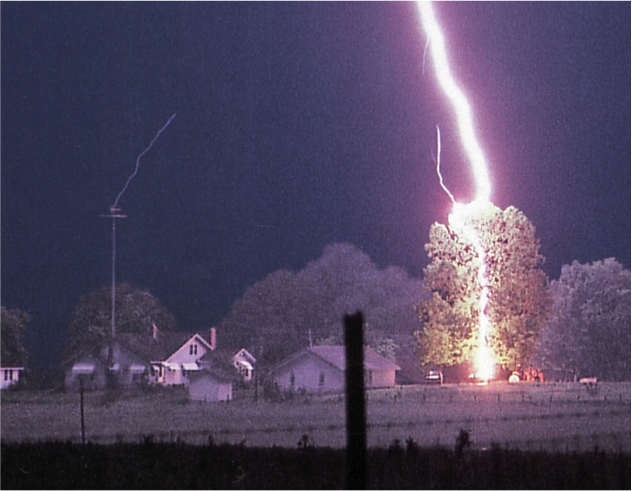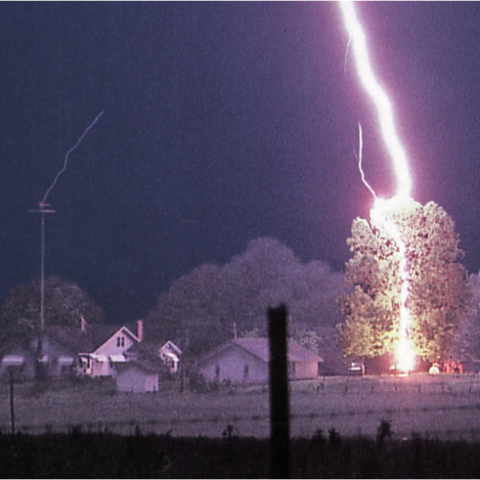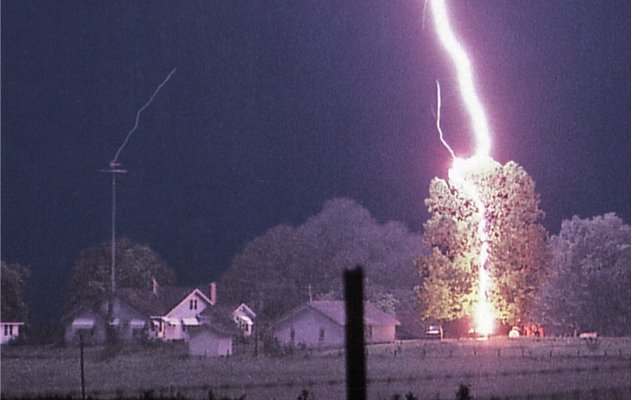Lightning is a random, yet devastating phenomena. Across the U.S., a lightning strikes on average 25 million times per year and occurs at a rate of 100 flashes per second worldwide. And according to the National Weather Service, the average strike has an average magnitude of nearly 30,000 Amps.
While lightning strikes are unpredictable and no location or facility is immune from the threat of a lightning strike, there are ways to reduce the risk or damage. Reducing the risk of damage from a lightning strike, direct or nearby, with the installation of a lightning protection system is not always a part of new construction projects. However, shouldn’t it be?
With modern urban and provincial development, commercial and residential facilities contain valuable digital electronic equipment used for day-to-day work and entertainment functions, meaning large investments are at risk during thunderstorms. A direct lightning strike delivers damaging energy, which even the most robust electrical devices and systems cannot withstand if protection measures are not correctly taken.
Lightning strikes are unpredictable and random events. There is no technology available that can prevent lightning from striking a structure or guarantee 100% protection. Lightning protection is based on statistical probabilities and the risk tolerance of the property owner.
Continue reading below as we uncover the science of a lightning strike, and how you can reduce the likelihood of damage to your facility from lightning.
The Science of a Lightning Strike
 Contrary to popular belief, lightning does not always strike the tallest object. Instead, the energy in a strike attempts to find the path of least resistance to ground.
Contrary to popular belief, lightning does not always strike the tallest object. Instead, the energy in a strike attempts to find the path of least resistance to ground.
The first step in lightning formation is cloud electrification, where charge particles with opposite charges separate and form a quasi-static electrical field between the cloud and ground. A down-leader then approaches, and the electrical field increases to a point of initiation of upward streamers. The upward leader propagates toward a down-leader to complete an ionized path between the cloud and ground. Competing upward leaders propagate toward the downward leader until one successfully connects. A highly ionized path is formed between the cloud and ground, allowing a large transfer of charge to ground. This event is over in milliseconds, and the overall duration of a “flash” lasts about 0.5 seconds.
The photo above captures a good representation of upward and downward leader’s formation. It also reinforces the unpredictability of a lightning event— the telecommunication pole is higher than the tree, and since the pole is well grounded, the lightning struck the tree.
For more information about lightning strike science, strike risks and lightning safety refer to the National Oceanic and Atmospheric Administration website for available resources.
Lightning Protection Systems
With this knowledge, you are probably wondering, “How does a lightning protection system work?”
That’s a great question.
There are different national and international standards that cover the manufacturing and installation of lightning protection components, including IEC 62305, IEC 62561, BS 6651, IEEE 998, NFPA 780, UL 96, UL 96A, Australian 1768, NF C 17-102 and others. The standards IEC 62305, IEC 62561, NFPA 780 and UL 96A are most commonly used.
There are two aspects of lightning capture, physical hardware (lightning rods/masts and overhead wires) to capture the strike, and the methods by which the hardware is positioned on the structures to achieve the desired “interception efficiency” or “protection level.” Positioning hardware on the structure is guided by one of the standards mentioned above, and different countries and regions have adopted different standards. The Electro Geometric Model (EGM), or Rolling Sphere method, is the most popular placement method and is published in most of the listed standards.
Although the EGM is the most used method, it assumes that the striking distance is the same for all objects, regardless of their height and shape. More recent research shows that more than 90% of strikes are to corners or other pointed features and that taller structures are struck more often than low structures or the ground. Observations also show that upward leaders can be longer than the nominal “striking distance.” The EGM does not account for those or other parameters, including:
- Leader charge distribution
- Leader propagation
- Electric field intensification created by the structure
- Position of the air terminals used for protection
- Variation in the lightning attachment probability of different competing features on structures
- Effect of altitude on air breakdown parameters.
However, the newer terminal placement Collection Volume Method (CVM) accounts for all the listed parameters, and can be used for placement of conventional and nonconventional lightning systems on the structure.
You can read more about the importance of air terminal placement and the CVM here.
Risk Management
A system designed in compliance with a standard does not guarantee 100% immunity from damage. Lightning protection is an issue of statistical probabilities and risk management. Lightning protection systems designed in compliance with standard should statistically reduce the risk below a pre-determined threshold.
Most lightning protection standards have a risk calculation method for assessing the need for direct strike protection (BS 6651, NFPA 780, IEC 62305, AS 1768, NFC 17-102). These assessment methods take into account lightning frequency, site ‘capture area,’ type and use of the facility and other factors. For instance, explosive, flammable, historical or hospitals represent examples of the facilities that have to be considered.
Based on the risk assessment results, the decision maker may deem it necessary to include lightning protection in their project. The final decision on protection level is typically left to the facility owner or the engineer making the recommendations. In many instances, it is appropriate to exceed the minimum requirements outlined in the standards.
Complete Facilities Protection Approach
In some cases, customers can ask for lightning protection only, with the assumption that lightning protection alone will provide all the protection they need. If a site doesn’t have proper grounding and bonding in place, the earth potential rise caused by a lightning strike may result in arcing and side flashing between metallic objects on the site and cause damage of the electrical equipment. The lightning protection and grounding systems dissipate most of the energy to the earth. However, residual energy can still harm sensitive electronic systems, which is why the implementation of surge protection devices is equally important.
Related resource: Keep an eye out over the next coming weeks for our post, Lightning Protection 101. It will cover the different terminal technologies available, as well as the different placement methods and when to use them.
Stay Updated on the Latest in Facility Electrical Protection
Want to stay updated on the latest tip and best practices in facility electrical protection? Subscribe to our blog to receive the latest information straight to your inbox.


